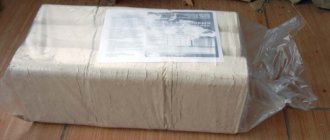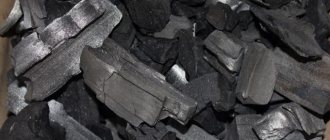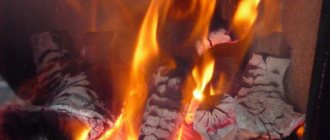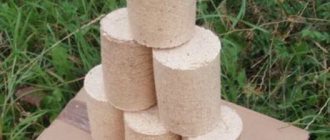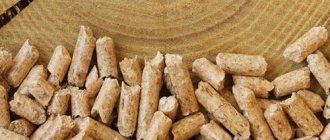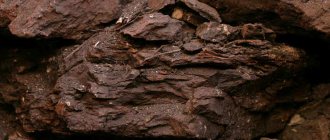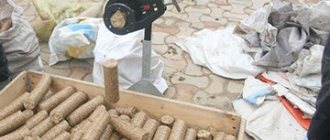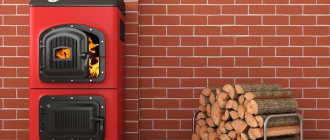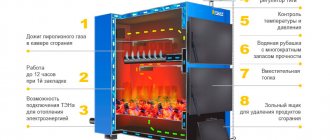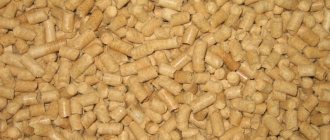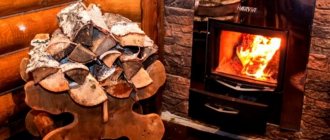Pros and cons of homemade briquettes
Advantages of homemade sawdust fuel briquettes:
- much less carbon dioxide is released than when burning wood or coal;
- compact product requiring little storage space;
- the material does not rot due to its high density;
- burns smoothly and beautifully;
- there will be no garbage and dust in the house;
- cost savings, subject to the availability of raw materials and equipment for manufacturing;
- briquettes burn for a long time - up to four hours;
- little smoke is produced;
- No harmful substances are released into the air;
- chimney cleaning can be done three times less often;
- environmentally friendly and safe;
- boiler power increases by 50%;
- burning coal gives an ash content of 20%, and briquettes 1-1.5%;
- A cubic meter of sawdust briquettes in terms of heat transfer is equal to 4-6 cubic meters of firewood.
Disadvantages of homemade sawdust briquettes:
- if the press force is insufficient, the briquettes may crumble;
- At home, ready-made briquettes are difficult to dry well. In the summer, they can be dried in the sun, and at other times of the year - only indoors, which does not significantly reduce humidity. Accordingly, they will burn worse.
- making and drying briquettes requires a lot of space;
- The manufacturing process is extremely labor-intensive and requires great physical effort.
Briquettes must be stored in a dry place. The shelf life of sawdust briquettes made at home does not exceed a year. The ash obtained from the combustion of the product is an excellent fertilizer.
Homemade sawdust briquettes are a cheap and safe fuel. If you have the opportunity to make them yourself, then briquettes will make the process of heating your home profitable and environmentally friendly.
Heating with regular wood
Firewood has been used for heating for a very long time; it is a high-quality fuel for the home and bathhouse, barbecue and barbecue. The environmental friendliness of firewood will always be 100%, and this fuel has plenty of other advantages. Let us note the main advantages of firewood, without delving deeply into this topic:
- First of all, I would like to say that the process of harvesting, drying and storing firewood is understandable to everyone. From an early age we know how to look for firewood, collect and light it.
- Lighting wood is not difficult, even when it is damp. Some tree varieties can burn in high humidity, giving off heat.
- The cost of firewood is low, even if you do not go through the entire harvesting cycle, but buy ready-made logs or logs. (However, until the prices of different types of fuel are compared, it will not be possible to say which is more profitable.)
- Firewood is not afraid of mechanical damage and can be stored in a woodpile in completely different ways.
- From an aesthetic point of view, the wood burns perfectly. They create a beautiful fire and soulful crackle, and when some varieties burn, a characteristic pleasant aroma appears. For open fireplaces, where the appearance of what is happening is important, this fuel is considered optimal.
- The substances released during the combustion of wood have a beneficial effect on humans, they calm the nervous system and heal the respiratory system.
Strategic forest reserve for winter
We will also highlight the disadvantages of natural fuel:
- To obtain high heat transfer, the firewood should be well dried under natural conditions, which requires an extremely long time, for example, 1 or 2 years. The best firewood is wood that has lain in a dry shed for a couple of years.
- During long-term storage, wood loses some of its qualities, especially fragrant varieties of trees.
- Firewood takes up a lot of space; for its normal storage in the required quantity, it is necessary to build an appropriate structure.
- When using firewood, a lot of debris always appears (chips, bark, wood dust, sawdust).
Good to know: How to split wood manually and mechanically
Having become acquainted with the main capabilities of the two types of fuel, let's make a comparison.
Popular types of wood briquettes
We have already talked about the production of fuel briquettes for heating boilers and furnaces, as well as their key advantages and disadvantages. It remains to figure out what types of briquettes are presented on the domestic market.
Fuel briquettes RUF
This fuel resembles white or wood-colored bricks in appearance (the shade varies widely). RUF briquettes are made from dry sawdust by pressing under high pressure. As a result, Euro-firewood is born, which can be used in any type of stove. Their distinctive feature is the inscription RUF, embossed on both sides.
RUF fuel briquettes for heating stoves are characterized by the release of a large amount of heat - they are almost one and a half times more profitable than firewood. They are easy to load combustion chambers and store them in stacks. Pressed bars are not afraid of moisture, but there is also no need to expose them to direct water. This fuel is supplied by many manufacturers - a typical example is. By the way, it also sells many other types of solid fuel.
Eurobriquettes PINI KAY
An interesting feature of these Eurobriquettes is their unusual shape - they resemble square pencils from which someone has taken the lead. That's why they are called "pencils". In order for it to burn with the release of a large amount of heat, a hole is made in it, increasing the draft. The “pencils” themselves look dark, as they were fired. This procedure makes them more durable and removes excess moisture.
The disadvantage of PINI KAY fuel briquettes for heating stoves is that they are more expensive than firewood and even more expensive than any other types of fuel. But they burn well, releasing a large amount of heat. They are also convenient to transport and store. Thanks to their shape, they are ideal for lighting fireplaces. Some people take them with them into the wild to use PINI KAY bars instead of wood for a fire.
Simple cylindrical briquettes
The simplest fuel briquettes for heating stoves are also on sale - in the form of cylinders. They are made from pressed sawdust and small wood waste. All this is pressed under slight pressure using a non-toxic adhesive base, after which the finished bars are sent to consumers. This fuel is cheap, but has one distinct drawback - low strength. It easily disintegrates and crumbles and does not withstand exposure to moisture.
Fuel briquettes from coal and peat
Peat and coal fuel briquettes for heating stoves are made from peat and coal, respectively. The starting materials are formed into small cylinders. The fuel can be used to light stoves and solid fuel boilers. Coal products give a high combustion temperature, but are characterized by high ash content. As for peat fuel, it is ideally suited for long-burning stoves, but it also produces a lot of ash.
Types of wood briquettes
The following types of pressed sawdust are sold on the Russian market: RUF, Pini Kay, cylinder-shaped fuel blocks, including those made from coal and peat.
RUF
These briquettes are made from dried sawdust by pressing under high pressure. They are similar in shape to brick, and the color ranges from wood to white. The inscription RUF is embossed on the front and back sides of the product. It is convenient to load bricks into the combustion chamber; they are not afraid of moisture. There are quite a lot of manufacturers of this form of solid fuel, and the quality of the fuel depends on them, but for an average estimate we can point out that RUF briquettes are 1.5 times more economical than firewood.
Pini Kay
The most expensive type of fuel is made from sawdust. Briquettes are nicknamed "pencils" because of their octagonal shape. Holes in the center of the logs create additional draft, which increases their calorific value. The blocks were fired during the production process, which made them harder and drier, and the surface acquired a brown color.
Standard cylindrical briquettes
This variety contains non-toxic glue. Pressing takes place at low pressure. The simplicity of the production technology of cylindrical fuel briquettes makes them the cheapest on the market. At the same time, they are fragile and very afraid of dampness.
Cylindrical briquettes made of coal and peat
By replacing the raw materials, they provide a higher combustion temperature, which allows for faster heating of rooms. Disadvantages: increased ash formation and unpleasant peat odor.
Advantages of coal briquettes
Increasingly, coal briquettes are used for heating not only in homes, but also in metallurgical and chemical plants, power plants, and boiler houses. They are made by crushing coal into small fractions (up to 6 cm). Then the prepared raw materials are mixed with the addition of a binder. Using hot steam and a press, briquettes are formed and sent to a special container for cooling.
Quality depends not only on the raw materials and compliance with the technological chain, but also on the binding component. When producing coal blocks for industrial use, binders such as coal tar, cement, petroleum bitumen, and liquid glass can be added. For household purposes, starches, molasses, and less often gypsum or lime are used.
Of all types of fuel, only coal does not produce smoke when burned. Coal-based briquette fuel can burn continuously for about seven hours if the air supply to the heating compartment is adjusted. As a rule, during the day it is necessary to load a new portion of briquettes into the oven no more than three times in order to maintain normal temperature conditions in the house.
Advantages of coal briquettes:
- long burning;
- high efficiency (95%);
- low percentage of ash yield (no more than 1%);
- less amount of carbon dioxide released than when using peat and wood;
- Convenient loading into the firebox.
In very cold winters, coal in briquettes for the stove is guaranteed to provide long-term, stable heat. Practice has shown that it is very convenient to use coal blocks for heating greenhouses and outbuildings.
Charcoal briquetting
When producing charcoal, about a quarter of it turns out to be substandard - small pieces and dust. To turn this waste into income, you can make briquettes from them. Charcoal briquettes can also be made at home; if necessary, you can make raw materials for this (charcoal yourself). The principle of briquetting charcoal is no different from the formation of the same fuel from coal:
- Substandard coal is crushed.
- Mix with binder. In this case, a regular starch paste will do the job well. The output should be a slightly moist mass. Some of the dust rolls into small lumps.
- The resulting mixture is fed into a press, where briquettes are formed.
This video clearly shows the entire technology of charcoal briquetting, but the guys created a form specifically for the customer (church tablets made from charcoal for incense were ordered). Similarly, you can make a mold of any configuration.
Conclusions. Briquettes from coal crumbs and dust (stone and wood) can be made at home. It is difficult to achieve commercial results (only through automation, and therefore expensive equipment), but for home use it is possible to make a simple installation.
How to properly burn with briquettes?
To achieve maximum results, you should properly heat the stove with fuel briquettes.
Sauna stove
To heat a bathhouse, you need fuel, which not only emits a large amount of heat, but also burns out longer. This will ensure a stable temperature for a long time. These are the properties that briquette products have.
When igniting the stove and firing it, you should adhere to the following tips:
- thoroughly clean the stove from ash and other fuel residues from the previous firebox;
- put some wood chips, paper, bark or other flammable materials on the grate;
- then put a small amount of eurowood and light the firebox.
Briquette stacking
Ignition
You should not use a large amount of fuel at one time, as this will lead to maximum heat transfer, which is not required by a sauna stove. It is better to put an average amount, leaving gaps between the briquettes for air blowing.
This type of fuel is very good for use in bathhouses. The aroma of essential oils from environmentally friendly wood materials fills the entire room and has a beneficial effect on the well-being and health of visitors.
Stove for heating a house
It is convenient to use fuel briquettes for the stove in the house. You can light them up and not throw anything else in for a long time. There are two ways to light Eurowood in a home stove:
- The first is similar to igniting fuel in a bathhouse: briquette fuel is placed on dry wood chips or paper. The fire is regulated by blowing.
Briquette stacking
- The second method is even simpler: a small batch of firewood is first burned. The heat after them is enough to burn the briquettes. They are packed loosely into the oven for faster burning. If you do not need quick heating, but want a long burning time, pack Eurowood more densely.
Ignition with wood
To heat your home, you can use coal or peat briquettes. They give a high combustion temperature, but also leave a lot of ash in the ash pan.
Ash from burning wood briquettes can be used as fertilizer in any garden plot.
After burning briquettes several times, you will be able to evaluate their effectiveness and find out their consumption. In the future, you can compare the number of briquettes needed and the amount of firewood for heating your home.
Fuel briquettes in Moscow and the Moscow region
Briketkin is always ready to offer its customers a wide range of fuel briquettes. Sometimes they are also called Euro firewood - the names are different, the product is the same. Since we specialize in them, keeping the quality of European firewood at the highest level and keeping prices as low as possible is our priority task.
Fuel briquettes in Moscow and the Moscow region are mainly purchased for heating
houses using fireplaces, boilers, furnaces and stoves. Many dachas in the Moscow region do not have central heating or a stationary source of gas, so they have to heat them with European wood, throwing it into the fireboxes.
In Moscow and the Moscow region there are the most places where you can buy fuel briquettes cheaply. One of these places is the Briketkin company. Our advantage is the lowest price on the solid fuel market
. This is due to large sales volumes, which allow us to purchase tons at minimal wholesale prices from manufacturers.
Manufacturers of fuel briquettes in the Moscow region, as a rule, are interested in very large sales volumes. Therefore, they work mainly with those who sell products to direct buyers, and not with the buyers themselves. It is quite rare to find a company that both produces and offers to buy its products in small volumes to end consumers.
The end consumer in Moscow and the Moscow region, that is, you, as a rule, cannot afford to purchase several tens of tons of wood briquettes
what manufacturers require. That's why companies like us come into being, allowing you to buy as much wood fuel for fireplaces, stoves, boilers and other fireboxes as you need.
When buying fuel wood briquettes in the Moscow region, you have a choice between sellers, which consists in price, quality and terms of relationship
. We, constantly comparing ourselves with competitors according to these criteria, do everything to remain a leader.
We offer to buy wood fuel in two options – retail and wholesale. Prices are completely transparent
– without complex discount systems that strictly depend on the quantity purchased. We have only two options - price per package and price per ton.
All products, including European firewood for the stove, can be purchased through the online store where you are located, or by phone - whichever is more convenient. The online store makes it easy to order any quantity of any product at the same time, and by phone it is much easier to arrange delivery in Moscow and the Moscow region and ask questions. After ordering through the website, the manager will definitely call you back, clarify everything and correct it if necessary.
Fuel briquettes are a unique and very effective fuel that has become available to us with the advent of certain modern technologies, having high density and low humidity. Wood fuel briquettes are wood particles compressed under high pressure - sawdust and/or dust
. These particles are connected to each other exclusively using the natural substance lignin. There is no point in adding any artificial binders to Eurofirewood, because production will cost more, and the substitution will be immediately noticeable to the consumer when used.
Buy inexpensive wood fuel briquettes from Briketkin if you are in Moscow or the Moscow region and come back to us again!
Fuel briquettes - what are they?
Fuel briquettes are a product of processing combustible waste, for example, ordinary wood chips. We cannot use wood chips to burn directly in a wood stove or boiler. There it will turn into a solid lump, which will give a minimum of heat. The resulting lump will have to be constantly stirred. Therefore, you can forget about such kindling.
And it’s a completely different matter when the same sawdust is compressed under high pressure into a fuel briquette. It will burn in boilers and stoves with an even flame, without crumbling into a pile of ash. It is this type of fuel that will be discussed in our review. It is made not only from shavings, but also from other elements - straw, peat, buckwheat husks, paper, tyrsa grass, sunflower husks and much more. During the pressing process, lignin is released from the raw material, which connects the individual components into a single whole without adhesive additives.
Advantages of fuel briquettes:
- They give an even flame and do not shoot embers.
- They create high temperatures in the furnaces.
- Form neat masonry.
- Provides long burning.
- Characterized by high heat transfer.
- They burn with a minimum amount of ash.
- Ecological cleanliness.
- Minimal soot formation.
- Supplied in the form of ready-to-lay bars.
There are also disadvantages:
- The higher cost compared to firewood is compensated by high heat transfer;
- They are afraid of dampness - storing them in a damp shed or outside will not work.
- Requires ignition using small splinters.
When choosing fuel briquettes, you need to read user reviews and pay attention to the materials used to make them. The highest calorific value will be provided by a product made from sunflower or wood
We also pay attention to density - the denser the briquettes, the higher the heat transfer and the higher the savings.
What are briquettes made from?
Basically, briquettes are the result of appropriate processing of products from the woodworking and food industries. They can be made from sawdust, rice or buckwheat husks, and even from seeds, as well as from straw, peat or tyrsa. Binders and sometimes glue are added to the main component. The composition of the briquettes is indicated on the packaging or in the relevant documentation. The composition affects the strength and shape of the briquettes and, of course, heat transfer, combustion rate, the amount of soot produced and other indicators that are significant to the user.
Special briquette production technologies involve ultra-strong pressing and maximum drying. Fuel briquettes are often called Euro firewood. This is deserved, since it is an excellent alternative to conventional firewood, and compliance with high quality standards allows this fuel to burn without the slightest harm to the atmosphere or human health.
- Fuel briquettes from sunflower seeds produce the most heat (5151 kcal/kg), are characterized by the lowest ash content (2.9-3.6%), and also contain a high concentration of oils. Due to the oil, their energy value increases, but the clogging of the chimney with soot is also high.
- Fuel briquettes made from wood are second only to seed briquettes in terms of heat transfer (5043 kcal/kg). The ash content is the same as that of conventional firewood (0.5-2.5%).
- Straw briquettes are slightly inferior to seed and wood briquettes in terms of heat transfer, but their indicator is still decent (4740 kcal/kg), but the ash content is let down - also rather large (4.8-7.3%).
- The fuel in tyrsa briquettes is characterized by very low ash content (0.7%) and very decent heat transfer (4400 kcal/kg).
- Rice husk briquettes are not very profitable - as much as 20% ash content and heat transfer of only 3458 kcal/kg.
- Peat briquettes deserve special attention. The specificity of the material determines their high ash content and the presence of harmful impurities in the composition. Therefore, they are not recommended for home use, but are more often used in industrial boilers and furnaces, where the main need is for low-quality and inexpensive fuel.
Advantages and disadvantages of fuel briquettes
Let's see what good fuel briquettes are for heating stoves, and what are their main pros and cons. Let's start with the positive features:
You are unlikely to have any problems with storing and storing European firewood.
- Ease of storage – thanks to its neat shape, Euro firewood and other briquettes can be stacked in neat, even stacks;
- High calorific value of fuel briquettes - if we compare them with ordinary firewood, they provide one and a half to two times more heat. Due to this, you can save on fuel when firing stoves and boilers;
- Briquettes are a long-burning fuel for any type of stove. Pressed sawdust burns one and a half to two times longer, reducing the number of approaches for adding new portions of fuel. If there is a regular stove in the room that burns with wood for 2-3 hours, then with fuel briquettes this time will increase to 4-5 hours;
- Uniform burning, without unnecessary noise and embers shooting in all directions. In addition, fuel briquettes used to fire stoves emit less smoke and produce less ash, reducing labor costs for cleaning;
- Low formation of resins - this reduces chimney clogging;
- The storage duration of fuel briquettes for heating stoves varies from 1 year to 5 years - it all depends on the manufacturing technology;
- High environmental friendliness - no chemicals are used in the production of briquettes;
- The volume of briquetted fuel consumed during one heating season is 1.5-2 times less than the volume of firewood used during the same time period.
Fuel briquettes intended for heating stoves burn smoothly and softly, releasing a large amount of heat. They do not clog stoves and chimneys and burn almost 99%.
If your home has a long-burning stove or boiler, then you will experience an additional benefit from using briquetted fuel - the combustion duration will increase by another 1.5-2 times, reaching 12-16 hours or more (depending on the model of equipment used).
Unfortunately, it was not without certain disadvantages:
We do not recommend storing briquettes outdoors; they can become damp and spoil.
- Fuel briquettes used to fire stoves are not afraid of dampness. However, they still do not like direct contact with water;
- Some types of briquetted fuel do not tolerate long-term storage - their shelf life is limited to one year from the date of manufacture;
- The cost of purchasing fuel may be higher than purchasing regular firewood - it all depends on the manufacturer;
- In some regions and localities, purchasing fuel briquettes for heating boilers and stoves is more difficult than buying a truckload of ordinary firewood;
- The cost is slightly higher than the cost of ordinary firewood. But due to the high calorific value and long combustion, you can save a little.
Despite all this, briquetted fuel continues to gain popularity.
Advantages and disadvantages
To understand how good fuel briquettes are, you should consider their positive and negative sides.
The advantages are as follows:
- Since Euro firewood has the correct shape, it is very convenient to store it.
- Fuel briquettes have a much higher calorific value than firewood. This results in savings on raw materials.
- Suitable for any stoves and gas boilers. Due to the long burning of compressed sawdust, adding new portions of raw materials occurs much less frequently.
- The combustion is uniform and silent, small coals do not fly around. When using raw materials, the emission of smoke and the formation of resins and ash is insignificant. This leads to a reduction in labor costs for cleaning and cleaning chimneys.
- Depending on the method of production of Euro firewood, their shelf life ranges from one to 5 years.
- The bars do not contain chemicals, therefore they are considered an environmentally friendly product.
- During one heating season, 1.5-2 times less briquette fuel is used compared to conventional firewood.
- Eurobriquettes burn slowly and gently. This generates a lot of heat.
In addition to the positive qualities, compressed products have some disadvantages:
- During storage, avoid exposure to water.
- Some types are stored for no more than one year.
- The cost of raw materials is quite high.
Today, the productivity and demand for briquetted fuel is growing. The price of European firewood is high, but you can save money thanks to their properties.
Cost of fuel briquettes.
It may seem that the cost of fuel briquettes is high, but this is not so. The company's employees will help you determine the required number of briquettes for your home and calculate the exact cost. Using fuel briquettes instead of conventional fuel will help significantly reduce costs.
Sometimes the cost of one briquette seems prohibitively high. But after the final calculation of the total volume of fuel required for heating during the heating season, this misconception will disappear. It turns out that this type of fuel is much more economical and less expensive than conventional wood fuel. This is understandable: instead of a large amount of firewood, just one or two briquettes are enough. It's simple, there is a very large amount of wood in a fuel briquette, there is more of it than in a wooden block of the same volume.
Briquette fuel with a volume of 2 tons will generate the same heat as ordinary firewood with a volume of 4.2 tons. The fuel briquette burns for a long time and produces a lot of heat. The humidity of fuel briquettes is 6-8%, along with this, the humidity of dry firewood is 20-25%. The lowest humidity allows the briquettes to quickly flare up and direct all the energy to the heating process. And when burning wood with high humidity, energy is wasted on removing moisture.
The briquette has increased strength, which prevents oxygen from getting inside, which increases and prolongs the combustion process. Nowadays briquettes are used everywhere, so there is no need to buy coal. There are briquettes in two price categories on the market: the more expensive Pini Kay type and the cheaper RUF.
Storage conditions for fuel briquettes
The clear shape and high density of the fuel blocks allows for a small storage area. On one cubic meter you can carefully stack up to two and a half tons of briquettes for the stove. In this case, the required level of environmental humidity should not exceed more than 80%.
It is not necessary to build a special room; compressed fuel can also be stored under a canopy. The main thing is that no moisture gets on it, and air circulates around it. Pressed husk fuel is considered to be the most vulnerable to moisture.
There are no harmful fumes coming from it. Not subject to spontaneous combustion. It practically does not absorb moisture from the air due to its high density. Therefore, performance properties are maintained for a long period of time.
The main reasons to purchase a biofireplace
Unfortunately, installing a classic stationary fireplace in a country house is limited by many technical nuances, and in an apartment it is completely unrealistic. However, there is an alternative to traditional fireplaces - a biofireplace.
- Environmentally friendly smokeless fuel.
Bioethanol is used as fuel in biofireplaces, which, when burned, emits a minimal amount of carbon dioxide, so there is no need to build a chimney. Also, no soot or ash is formed during operation.
- High-quality heating.
A biofireplace effectively heats a room, often outperforming its electric counterpart. In addition, the heating element in an electric fireplace is essentially a large hair dryer that dries the air in the room. As for the biofireplace, even a small model can cope with heating a room with an area of up to 20 sq.m., without drying out the air.
True, with intense heating, the room must be regularly ventilated, but this fact should not be considered a disadvantage, since an open flame warms very effectively, even when the window is open. As a result, we have both fresh and warm air in the room.
Easy to use and maintain.
The biofireplace is extremely easy to use and maintain. It does not require firewood, there is no need to constantly maintain a fire. At the same time, you can regulate the intensity of combustion, which cannot be done in a conventional wood-burning fireplace. All maintenance involves basic maintenance of cleanliness and periodic removal of fuel residues in the combustion chamber.
For an apartment, this is an ideal solution, since installation does not require any documents or permission from officials.
Better than other analogues.
A biofuel fireplace can be used in combination with aromatic oils for aromatherapy treatments right at home.
The bio-fireplace will perfectly decorate the interior of your room. On sale you can find a large selection of bio-fireplaces of various shapes, styles and sizes, so you can easily choose a model that will organically fit into the interior of your home.
For the manufacture and finishing of modern biofireplaces, materials such as metal, glass, veneer, marble and granite are used, and in some models even precious metals.
There are compact and even tabletop models of biofireplaces, with which you can add exclusivity to your work office and add zest to the decoration of your home.
Minimal disadvantages.
The disadvantages of biofireplaces in most cases can be called “cosmetic”.
- For example, if you do not light the fire immediately after turning on the fireplace, a faint smell of ethanol will appear in the room, but it will dissipate within a few minutes.
- Fire hazard. If you follow the instructions, the bio-fireplace is less dangerous than a regular wax candle, but despite this you should always remember that using fire is always associated with some danger.
- Price. If we talk about price, then at first biofireplaces really belonged to the category of heating devices available only to wealthy citizens, but those days are gone, today the price of a biofireplace is comparable to the price of an electric analogue.
What are the advantages of fuel briquettes
Fuel briquettes
The type of fuel in question is a new word in the field of heating stoves and fireplaces. In addition to heating the house, heating briquettes are suitable for heating saunas and baths. You can enjoy the beautiful flame and warmth of the hearth - all this is possible with Euro-firewood. So, let's look at their main strengths:
- briquettes are suitable for laying in any types of stoves, solid fuel boilers and fireplaces, for baths and saunas;
- high calorific value of 4500-4900 kcal/kg (for conventional firewood no more than 2700 kcal/kg), due to which Euro-firewood has a 1.5–2 times higher combustion temperature;
- briquettes burn almost completely, have a low ash content and do not leave soot - they practically do not pollute the firebox and chimney, and accordingly, maintenance of heating equipment is significantly simplified;
- Briquettes have low humidity (no more than 8%), which is explained by the production technology - they are forcibly dried in special chambers;
- due to low humidity, European firewood flares up quickly and has higher efficiency;
- Euro firewood is a completely harmless and environmentally friendly product, which does not contain harmful chemicals; during combustion, very little CO2 is released;
- wood briquettes do not smoke, do not spark and do not leave an unpleasant odor;
- light weight and convenient packaging ensure ease of transportation and storage;
- Briquettes are packaged in plastic film, which allows them to be stored for a long time without signs of rotting.
Fuel briquettes for the fireplace
Fuel briquettes are a type of solid fuel, an alternative to conventional firewood or coal.
Due to their correct shape and uniform size, they are also called Euro firewood. They can be used in fireplaces, stoves, solid fuel boilers and other heating devices that burn solid fuel.
Briquettes are made from waste from the wood processing and food industries - sawdust, rice husks, buckwheat or seeds. They also use accessible and inexpensive materials that have energy value: straw, peat or tyrsa (herbaceous plant).
The briquettes do not contain glue or other binding elements. The briquette gains strength and shape through strong pressing and maximum drying. Therefore, burning them does not harm human health.
A high-quality briquette is made of sawdust and wood chips; it is dense and breaks with great effort. The packaging should not contain a large amount of loose sawdust.
They come in different types:
- “Bricks” are produced in a rectangular shape (60 × 90 × 150 mm). They have the best price-quality ratio. The material is easy to store and has a high density. When burning, it practically does not emit smoke or burning smell, and also does not clog the chimney.
When choosing, try to avoid white materials with a fine-grained structure. Most likely, they were made from waste from the production of plywood and MDF boards - birch and pine dust. This dust comes from grinding, and the raw material for briquettes contains not only wood, but also various resins and glues, which are harmful to both the stove and its owner.
“Square with a hole” briquettes are characterized by high density and have the shape of an irregular polyhedron with a characteristic dark crust from firing and a hole in the center. Dimensions – 60 × 200-300 mm.
They have three times the surface area, so they burn very intensely and beautifully. They are mainly used for fireplaces and barbecues, that is, where the aesthetic pleasure of contemplating fire is more important than the cost of heat and the duration of combustion.
Without exception, all fuel briquettes made from pure sawdust have a very low ash content (up to 1%, from 100 kg of fuel a maximum of 1 kg of ash is obtained), do not spark, and do not smoke. Due to the significant density and low humidity (up to 8%), a high combustion efficiency is achieved.
Advantages of fuel briquettes:
- Ideal as fuel for fireplaces, stoves, solid fuel boilers;
- Availability for sale. Briquettes can be purchased in supermarkets, stores, the Internet, etc.;
- Briquettes are packaged in convenient packaging that does not contaminate anything during transportation, and they are also convenient to store;
- Theoretically, briquettes should have a moisture content of less than 10%;
- Good briquettes have a high energy value, which generates a large amount of heat over a long period of time;
- The briquette burns to the end, without leaving much ash;
- Good briquettes do not pollute the chimney and do not cause corrosion;
- There is an ecological and renewable energy source;
- A good briquette does not crumble and does not turn into a pile of sawdust;
- Ash after burning a briquette is a fairly good natural fertilizer;
- When burning briquettes, the glass is not contaminated;
- Does not pollute the environment;
- Briquettes can be placed in the fireplace and left undisturbed for a certain period.
Disadvantages of wood briquettes:
- Briquettes should only be purchased of good quality, because not every product made from compressed chips has the right to be called a “fuel briquette”;
- You cannot buy briquettes made from MDF sawdust, plywood, slabs or other waste. Burning such pseudo-briquettes will clog the fireplace and smoke duct;
- When burning wood, we burn bark, which has resin. This contaminates the glass and the fireplace;
- The wood must lie for at least 1.5 years to obtain natural drying;
- It is also not recommended to use briquettes made from pine trees, since they contain resin residues;
- You can buy briquettes with high humidity;
- Briquettes do not produce a beautiful fire, but they do produce high temperatures;
- You need to learn how to burn with briquettes, since combustion is significantly different from burning wood.
Pros and cons of fuel briquettes
Now let's look at Eurowood . Fuel briquettes are made from waste from woodworking and furniture factories. The shavings or sawdust are usually crushed. Then the resulting wood flour is pressed under high pressure and the output is “bricks”, “cylinders”, “tablets”, glued together with lignin - a natural polymer.
Fuel briquettes are also made from agro-industrial waste - sunflower husks and straw. From peat and coal.
Advantages of wood fuel briquettes:
- High specific heat of combustion – 4500 – 5000 kcal (5.2 – 5.8 kW*h per 1 kg)
- A small percentage of humidity - 8 - 10%.
- Low ash content – 1%.
Coal fuel briquettes provide greater specific heat during combustion than European firewood, but they have a higher ash content.
Practice shows that fuel briquettes, which have a higher density (about 1000 kg/m3) and lower humidity, burn longer and better than firewood.
vita01FORUMHOUSE user
I will share my experience. There is no gas. The allocated electrical power is small. I don’t want to heat myself with diesel or coal. He heated a solid fuel boiler with dry wood and briquettes. It’s more convenient for me to heat myself with fuel briquettes rather than prepare firewood for future use. Dry them. Briquettes take up three times less storage space than firewood. They burn longer. One bookmark is enough for a day. I want to properly insulate the house and then, I think, the briquettes will be enough for 2 days.
But briquettes are different. Quality greatly depends on the manufacturer and raw materials. Careless manufacturers use waste from plywood production with phenol-formaldehyde glue. Waste from sawmills - bark, croaker. This affects the quality of European firewood and its calorific value.
XUWHUKFORUMHOUSE user
I bought briquettes in the form of “bricks” to try. Didn't like it. They take a long time to flare up. There is little heat from them. The boiler does not reach maximum power. Before them, I tried fuel briquettes in the form of “cylinders” with a hole in the middle. They burn much better. And they provide much more heat. But they cost more. By the way, even those briquettes in the form of “bricks” still burned better than firewood. Maybe I just came across raw briquettes?
Unlike firewood, fuel briquettes are not purchased with a reserve for 2-3 years in advance. The fresher the product, i.e. just came from production, so much the better. During long-term storage, even Euro-firewood packaged in protective film, accumulates excess moisture, which worsens its calorific value.
According to Andreyraduga, when buying fuel briquettes, pay attention not to the name, but to what they are made of . The user bought different briquettes for the fireplace. For example, brown “cylinders” with a hole in the middle, although the most expensive, burned out very quickly. “Bricks”, made not from shavings (this can be seen by eye), but from wood flour and tightly pressed, burn long and hot and produce a little ash.
Ham59FORUMHOUSE user
Heated a house with an area of 210 square meters. m birch firewood, but there is a lot of tar about them. I bought fuel briquettes “bricks”. Within a month, one pallet of European firewood was gone + I bought 20 more packs. Total spent 6100 rubles. If it is 10 - -15 °C outside, then one pallet of Euro-firewood is enough for heating. Well, once a week I burn 2-3 aspen logs to clean the boiler and chimney. I used softwood briquettes. The fraction is almost sawdust. They burn very quickly. Unsuitable. Birch briquettes in Perm cost 55 rubles. for 1 pack of 12 pcs. There are 96 packs on a pallet. Total - 5280 rub. Coniferous briquettes – 86 rub. for 1 pack. A pallet costs RUB 8,256. Not profitable. For comparison: when heating with electricity, 2 heating elements of 3 kW each, 10,000 - 12,000 rubles were spent per month.
Comparison of briquettes with conventional solid fuel
The cost of coal, firewood or pressed sawdust used for heating varies depending on the region. Therefore, there is no clear decision on the choice of one type of fuel or another.
It is necessary to take into account the current price and conduct an analysis of comparative characteristics
Specific calorific value
One of the main indicators of fuel efficiency is its specific calorific value (specific heat of combustion). This parameter determines how much mass fraction of a substance, when burned, will be required to release a certain amount of energy.
Comparative calorific value of various types of fuel. The values given are approximate and depend on many factors. But in general, the table shows the rating of solid fuels by specific calorific value
There is one nuance here: calorific value depends on mass, and firewood and sawdust briquettes are usually measured in cubes. When advertising compressed fuel, they often indicate that the energy output is almost twice as high as when burning wood, but they do not indicate the fact that the weight of dry briquettes per cubic meter is greater.
Let’s assume that the calorific value of freshly cut birch is about 2 kcal/kg, and that of briquettes is 4 kcal/kg. The weight of a folded cube of firewood is about 570 kg/m3, and the weight of the same volume of pressed material is about 800 kg. Therefore, a cubic meter of raw chopped wood when burned will give about 1.14 mCal, and briquettes - about 3.2 mCal, that is, almost three times more.
The thermal efficiency of industrially produced briquettes can be compared with charcoal or coal, but the latter is much cheaper.
Storage and ease of use
One of the disadvantages of pressed raw materials is its high hygroscopicity. The intense ability to absorb moisture leads to a loss of rigidity between the bound particles and possible crumbling of the briquette. Therefore, unlike coal or firewood, sawdust must be stored in a dry place.
Fuel briquettes can also be kept indoors. Industrially produced pressed raw materials practically do not produce waste, unlike the same firewood.
Due to the dirt and dust created, coal and firewood are stored outside. Neat briquettes made from shavings can be kept in the veranda of your home
Pressed wood requires a minimal amount of ignition material to start burning. Here sawdust, like peat, has no competition.
Application in long-burning boilers
Nowadays, long-burning boilers are deservedly popular, especially among cottage owners. They are economical, have high efficiency and are easy to operate. Their only significant disadvantage is the cost of the equipment and the costs of its installation.
Many advanced boiler models are equipped with an automated fuel loading system. For its operation, it is necessary to use a combustible material of uniform shape. For this purpose, pellets are made from sawdust and shavings.
Pellets are made from wood waste by pressing. They have the form of granules with a diameter of 6-9 mm and a length from 10 to 70 mm
The use of this type of fuel in such boilers allows maintaining the required temperature without human intervention. This allows cottage owners to be away for a long period (up to several days) without the risk of the home cooling to unacceptable levels.
Advantages and disadvantages of the product
Sellers of coal briquettes insist that the calorific value of their product is significantly higher than that of other types of fuel. This may be true, since the heat of combustion of 1 kg of anthracite is 8 kilowatts, and firewood and wood-based briquettes emit up to 5 kW/kg. The advantages of briquetted coal also include:
- enlargement of particles of the initial fraction;
- reducing the volume of harmful emissions into the atmosphere during combustion;
- high quality products with standard indicators;
- ease of storage and transportation;
- ease of spending control;
- combating spontaneous combustion of fine coal;
- environmental cleanliness and absence of harmful chemical additives;
- high heat transfer;
- ease of ignition and burning duration.
https://youtube.com/watch?v=jgT9fpwDmZw
However, owners of solid fuel boilers cite a number of reasons for the low popularity of coal briquettes in comparison with their wood counterparts. The disadvantages include the following:
- the equipment is difficult to heat, and the fuel does not provide enough heat;
- when burning in the premises there are unpleasant odors;
- products crumble freely and become shapeless during transportation;
- A large amount of ash is formed.
Negative reviews are understandable if we remember that unscrupulous manufacturers, in order to obtain maximum profits, try to use charge, sludge and other coal products that are unsuitable for heating needs. Real anthracite briquettes with a rich black glossy color are difficult to find on sale. This leads to the logical conclusion that it is preferable to make coal briquettes yourself and purchase high-quality raw materials for this.
You should not waste effort and money on pressing low-calorie types of coal, although such briquettes, in proper combination with firewood, will significantly reduce overall costs during the heating season. Manufactured using a homemade method, they differ unfavorably from factory-made analogues: they produce little heat when burning, are fragile and are destroyed during transportation. But here it is possible to take care of the quality of the source material and adjust the content of additives. And the cost of homemade bricks, pillows and sausages turns out to be much more attractive than the prices of their factory-made counterparts.
Equipment for the production of pellets
The main role in the technological process is played by the machine for the production of pellets, which is also the most difficult to manufacture. It will not be possible to completely make a granulator with your own hands, since to manufacture the matrix and rollers you need metalworking machines - lathe, milling, drilling and grinding. So there are 2 options: buy a ready-made matrix-roller pair or order it from the craftsmen.
The matrix pair for the pellet press should be made of high-carbon steel St45 or St50, or even better alloyed with manganese HVG or 65G. Moreover, after processing, the parts must undergo a hardening process in order to achieve a hardness of 58-60 units. To make a matrix for a granulator, you need to maintain all the dimensions indicated in the diagram:
You can use simpler steel for the roller shaft - St3, 10 or 20, and there is no need to harden it. But the working parts of the rolls must be made from the above grades, followed by hardening, and then mounted on the shaft through bearings, as shown in the photo below.
Now let’s talk about what you can use to assemble the housing and drive for a homemade pellet granulator. The matrix pair must be placed inside a cylindrical body, which is made of sheet metal or a pipe with an internal diameter of 200 mm. The drive shaft is inserted into the matrix hole and secured with a key, and below you need to make a platform for the finished pellets. The assembly diagram of the pellet granulator is shown in detail in the video:
Watch this video on YouTube
To rotate the shaft, you need to take an electric motor with a power of at least 5 kW, and the drive can be assembled from an old automobile gearbox from a Volga or Moskvich with part of the rear axle. On the side where the driveshaft is to be connected to the gearbox, a pulley is installed, rotated by a belt drive from an electric motor. Both units are attached to the same frame, as described in the video:
Watch this video on YouTube
Note. In this design of a press for making pellets with your own hands, the shaft rotates the matrix, and the rollers remain stationary. The pulleys must be selected so that its rotation speed is no more than 250 rpm.
Homemade crusher
It’s good when it is possible to obtain good small wood waste from some production for pressing pellets. If this waste contains small branches or slabs, then to grind them you will need additional equipment - a crusher. There are many homemade structures, but most of them cut wood into chips that are too large, from which it is impossible to make pellets at home.
We present to your attention a simple wood waste crusher made from 3 dozen circular saws for a circular saw with carbide tips. All saws are mounted on one shaft in such a way that the teeth of each subsequent one are slightly offset relative to the previous one. A pulley and 2 bearings at the edges are placed on the same shaft, after which the entire structure is fixed to a frame made of angles or pipes.
As you understand, the productivity of the unit is low, but such a wood waste crusher will produce sawdust suitable for the production of pellets. If you have a circular saw on your farm, then the chopper can be adapted to its frame, as is done in the photo:
Sawdust dryer
To ensure that home-made wood pellets do not crumble at the exit from the granulator matrix, it is necessary to ensure the minimum moisture content of the raw materials. In industry, this occurs in various drying chambers. At home, craftsmen have adapted to assembling drum-type sawdust dryers, since their design is the simplest, as shown in the diagram:
Several iron barrels, welded to one another, are mounted on a frame with a slight inclination to one side. Blades are welded from the inside to the walls of the barrels to mix the raw materials. On one side, hot air is supplied inside such an improvised drum using a gas or electric heat gun. The rotation of the drum is carried out by an electric motor through a gearbox or a reduction belt drive.
Read with this
- Technology for manufacturing fuel briquettes from sawdust + video
- Methods for processing solid waste
- Is the use of boilers using sawdust and wood chips justified today?
- Design and diagram of a pyrolysis boiler
- How to choose a changing table for a newborn
- Fasteners for walls made of cellular and hollow material
- Making a fireplace out of boxes for the New Year with your own hands
- Specific heat of combustion of fuel
- Is it worth it and is it possible to store a bicycle on the balcony in winter: advantages and consequences
- The process of preparing activated carbon at home
What are fuel briquettes made of?
Euro firewood is small bars consisting of dry crushed waste compressed under high pressure: wood shavings, grinding dust, sawdust, pine needles, peat, husks, straw (and other agricultural waste). The main advantage and main feature is the use of exclusively natural raw materials. No formaldehydes, resins, adhesives or other chemicals are used as binders. During the briquetting process, the bonding of raw material particles to each other occurs due to lignin, a substance that is contained in the wood itself and is released during the technological process.
